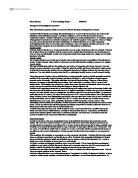Critically examine the contribution of studies of suicide to a sociological understanding of deviance in society.
Aislinn 09/05/2007
Critically examine the contribution of studies of suicide to a sociological understanding of deviance in society.
A number of sociologists have studied the topic of suicide both in a positivistic way (Durkheim) and in a phenomenological way (Douglas and Atkinson). Deviance is an activity that is not seen as ‘normal’ in society, this generally means that it does not coincide with the common norms and values of society. In this sense suicide is seen as deviant as it is not a practice that is seen as the norm. This essay will examine the contribution of studies of suicide to a sociological understanding of suicide in society.
To explain suicide Durkheim uses a positivistic approach. This means that he uses quantitative research to compare the incidences of various social factors with the common incidence of suicide this is known as multivariate analysis. Durkheim believed that suicide is directly linked to the levels of social integration and he placed societies into four levels depending on their level of social integration. An egoistic society is where people are encouraged to look after themselves and those close to them at the expense of the wider society. This means that social bonds are weak and there is a low level of social integration and is generally found in protestant societies as Protestantism stresses the need for people to make their own decisions and to accept the responsibility of doing so. In these societies’ individual failure or unhappiness are grounds enough for committing an egoistic suicide. However, he also says that within these societies there are institutions that contradict the values of an egoistic society, like Catholicism and the family. This means that in societies with a low level of integration there are likely to be high rates of suicide, but in societies where people have a sense of belonging this is far less likely. Another form of society according to Durkheim is an Altruistic society. In this kind of society the welfare of an individual is not as important as the welfare of a group. This means that individual unhappiness is not important and therefore suicide is far less likely. However when an altruistic suicide is committed it is when an individual is expected to commit suicide on behalf of the wider community as would be the expectations on a suicide bomber. This would mean that suicide would be seen as less deviant as it would be to help society, rather than for individuals own selfish reasons. An Anomic society is another form a society that Durkheim explains. In these societies, he claims, cultural and mechanical restraints are put in place to provide a clear-framework for what is acceptable behaviour. However, if there is some for of change and these restraints are weakened people resort back to their natural selfish-ness. Thus, in an anomic society suicide can be linked to periods of rapid social change, such as in America in the 1930s. The final society that Durkheim explains is the Fatalistic suicide; this is a rare form of suicide and usually happens in very oppressive societies. When some-one is oppressed they may loose the will o live and therefore commit suicide, such as in the case of Diane Pretty who was terminally ill and no longer wanted to live. This form of suicide would be seen as deviant as it goes against what is expected of a person, even under extreme pressure.







